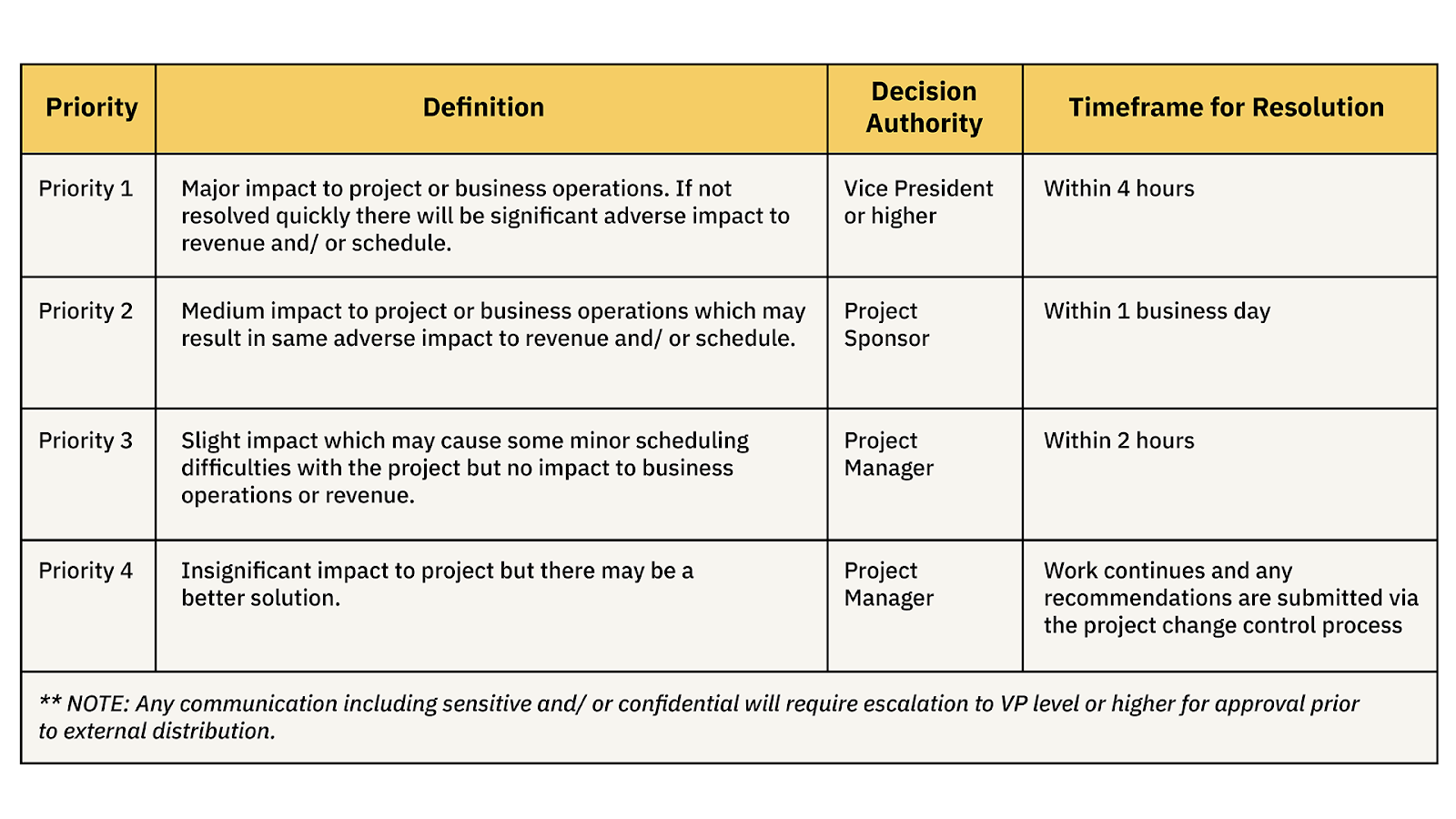A successful project requires careful planning and precise execution.
In addition to this, it also requires an effective and transparent communication plan to make sure that all stakeholders are updated on the progress at regular intervals. A communication plan is a handy tool when it comes to defining the objectives of your communications or identifying stakeholders and communication channels. You can also use it to establish a feedback loop that keeps everyone involved up to speed. By preparing the communication plan in advance, you can ensure that all recipients can clearly disseminate information.
What is a project communication plan?
A project communication plan identifies how important information will be communicated to stakeholders throughout the project duration. It also determines who will be receiving the communication, when and how those people will receive it, and how often they should expect to receive that information.
A project communication plan is an agreement between the collaborators and stakeholders. It outlines what, when, and how the information will be shared at key intervals. Information like status updates, task-related questions and meeting details should all be included in it. The goal is to define and streamline team communications as much as possible. A good communication management plan guarantees effective communication throughout the life of a project.
Free Download: Project Communication Plan Template
Why is a project communication plan important?
Communication is the backbone of any project. The benefits of a good project communication plan include staying in line with the budget, timeline, and scope expectations, to name a few. The right strategy can solve most major communication breakdowns before they even happen. A communication plan is vital in project management because it helps get stakeholders, clients, freelancers, and team members all on the same page. Communication plans fail if there is excessive discussion around the project or if the scope of each interaction is not defined. These issues can have a significant effect on deadlines and budgets.
A project communication plan also establishes professional boundaries. For example, some stakeholders may want to limit their interaction to email, whereas some may be comfortable texting when the conversation is time-sensitive.
A project communication plan helps keep the project on track because it:
- Creates written documentation that the team can refer to when required
- Sets and manages expectations of when stakeholders will receive updates
- Defines how critical information will be delivered throughout the project, by who, and at what frequency
- Increases stakeholders’ visibility into the project and its status
- Provides the opportunity for stakeholders to give feedback, which can help the team detect issues early on and decrease wasted work
- Increases productivity during meetings or eliminates meetings altogether
- Ensures the project continues to align with goals
What should a good project communication plan include?
While the specifics of your communication plan will vary depending on the project type and scope, there are a few essential items that should be included in every project communication plan you create:
Key stakeholders
Note down all the key stakeholders, including your primary client contact. Include contact information such as phone numbers and emails so that anyone who accesses the communication plan can find this information.
Team members
Include the main team members from your project team along with their roles. This is handy for anyone unfamiliar with the project. List who on your team is involved in the communication of deliverables, leading strategic discussions, or how you’ll handle technical conversations between stakeholders and your team.
Communication methods
Outline the primary communication methods and different channels you will be using to contact stakeholders. Include notes on stakeholder’s preferred channels.
There’s no single right way to communicate on a project. The communication plan can and should include a variety of communication methods. Here are a few to consider:
- Meetings (in-person, phone, or video chat)
- Discussion boards
- Slack
- Social media
- Status reports
- Collaboration apps
- To-do lists
- Surveys
Communication type
Include the types of communication, how the information will be shared, what will be included, and who that communication will be for. For example, you might be providing weekly status reports to the client. Think about how you will provide this, who it will be provided to (stakeholders from the client’s team), and what information needs to be reported.
Communication style
You can break this down based on stakeholder and communication methods. Does a particular stakeholder prefer formal communication only, or can you be a little more casual in your tone?
Meeting schedule
While you can adjust this as required throughout the project, having an initial idea of how often you’ll be meeting with stakeholders is helpful. Depending on the scope of the project, you might also want to outline how often you’ll be emailing the client. Include internal team meetings as well in your meeting schedule.
Key messages
Determine the key message or information that you will communicate to each stakeholder throughout the project. This also includes any information or feedback you will need from them.
Communication goals
A communication plan that includes communication goals can help ensure you make decisions based on what you’re trying to achieve.
Five tips for nailing a project communication plan
The following tips will help you create an effective project communication plan.
- List your project’s communication needs. Every project is different. Take the size of the project, the nature of the work involved, and even the client’s unique preferences into account as you determine which types of communication this project needs to succeed.
- Define the purpose of your communications. Bombarding people with too many emails or unnecessary meetings can interfere with their ability to get work done and cause them to overlook essential updates. Be purposeful in your plan, and ensure that every communication has a reason for existing. If you’re feeling ambitious, go ahead and outline a basic plan for the topics that you will cover in each meeting or report.
- Choose a communication method. Do you need a meeting to share weekly updates, or is your project discussion board enough? Think through how your team works best, so they can stay in the loop while still being productive. If your client prefers the personal touch of a phone call, build that into your plan too.
- Set a cadence for communication. Establishing the frequency of communication helps set clear expectations from the get-go. This will free you from fielding random requests for status updates and help project members carve out time for important meetings and reports ahead of time.
- Identify the owner and stakeholders of the communication. Assigning ownership creates accountability so your carefully crafted plan can reach its full potential. As the project manager, you’ll be responsible for most communications, but there may be some you want to delegate to others. So while you’re naming names, list the audience or stakeholders for each communication type too. That way, key players come prepared to provide updates.
A key aspect that you should consider as a part of the project communication plan is managing sensitive information. There may be times when not knowing whom to contact and what information to give them could be a security risk. It is vital to plan for this possible scenario when crafting the communication plan. Crafting a flowchart that shows how to share sensitive information in the early stages will be beneficial going forward.

Communication escalation
Efficient and timely communication is the key to successful project completion. As such, any disputes, conflicts, or discrepancies regarding project communications must be resolved in a way that is conducive to maintaining the project schedule, ensuring the correct distribution of communication, and preventing any ongoing difficulties. To ensure projects stay on schedule and issues are resolved, you could use a standard escalation model to provide a framework for escalating communication issues. The table below defines the priority levels, decision authorities, and timeframes for resolution.

Free Download: Project Communication Plan Template
How to use a project communication plan
- Share it with your team. Sharing the plan with your team will inform them of your communication cadence, which affects their work and delivery dates and gives them more context around how you’ll be communicating and with whom. Sharing this information means your team can help support you as you carry out the communication plan.
- Stay on track. Make sure your team knows and understands your communication plan so that your client gets consistent, meaningful information relayed to them throughout the project. Book any key project meetings as soon as you have a plan in place, and add reminders to your calendar for regular check-ins and even project emails so that you stay on track with the essential items you’ve defined in your plan. If you find yourself straying from your communications plan at any point and have trouble getting back to it, reconsider the approach you’ve defined.
Common pitfalls to avoid when creating a project communication plan
Here is a list of common pitfalls and how to avoid them when designing the project communication plan.
- Poor communication. Communication is the driving force in the majority of situations. Choose proper channels of communication. Do not forget about face-to-face conversations. Hold meetings regularly and choose the right way to speak to your colleagues.
- Lack of trust and delegation. To avoid this pitfall in project management, a manager can delegate tasks to people who will do their best to accomplish them. Moreover, trust and delegation have a psychological impact on participants. They boost morale, and everyone feels like a part of a team and not just gears in a complicated device.
- Unclear roles, responsibilities, and deliverables. To be aware of where everything goes, everyone has to know their roles and responsibilities and what is expected at the end of a project. Hold a meeting at the very beginning that will set all expectations and the overall course. This helps teams get more organized and self-managed.
- A poorly created project plan. A project plan is a formal document where all decisions with project scope and other relevant information are included. A skillfully prepared plan answers all questions about a project. Therefore, its preparation requires deep knowledge and skills from a manager.
- Lack of breaking down projects into smaller tasks. Projects are usually huge and long-term. Divide all work into smaller pieces with clear short-term time limits, objectives, and tools to perform them. Consequently, you create an atmosphere where team members feel comfortable about manageable tasks and time limits.
- Weak resource management. Diverse kinds of resources make up projects. Some of them are materials like equipment, labor force, etc. Make sure to customize the working days in advance and detail. Consider all working days, days off, and vacations. Remember, resource management is as important as any other activity in a project. Also, ensure all resources are allocated according to their abilities. Reallocate them if needed.
- No attention to people management. Proper team management leads to better communication and understanding within a project. Conversely, lack of people management leads to unsatisfactory task fulfillment and missed deadlines. Speak to your colleagues, remind everyone how their role is important for successful project fulfillment. Hold team meetings so that everyone can get a clear picture. Hold stakeholder meetings for better project stakeholder management.
- Improper risk management. Do your best and calculate as many risks as possible from the very beginning. Share your ideas with your team members, the results of your calculations, and prepare them for each situation, even the worst one. The more they know about risks and plan for them, the better it is for the whole project.
- Unrealistic deadlines. Give up the practice of setting unrealistic deadlines. It is a slippery slope. Once colleagues notice that a manager tends to set unattainable deadlines, they may lose trust in the manager.
Project communication plan template
Having a project communication plan gives you the tools to communicate effectively and notice red flags as soon as they occur. A plan also allows you to re-evaluate your approach and your client’s needs if required and determine whether communication through other methods may be more effective. Regardless of how formal or informal your project communication plan might be, it can be the difference between a highly successful, efficient project and a project that is merely skating by without a solid plan in place. Think of it as another way to set and check expectations throughout a project and ensure meaningful, successful communication with ease.
Here is a free Project Communication Plan template that you can use to ensure effective communication for your project. It is customizable, so you can modify it to suit your needs.



















